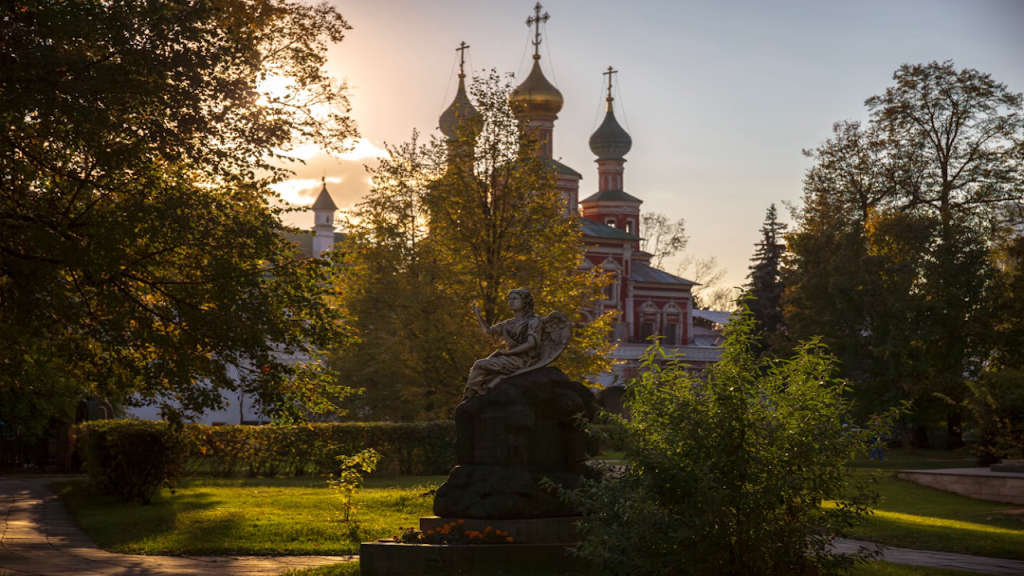Are you planning a trip to Moscow, Russia? If so, be sure to add St. Basil’s Cathedral to your itinerary. This iconic landmark is a must-see on your Moscow travel tour and offers a glimpse into Russia’s rich history and breathtaking architecture. Whether you’re interested in historic landmarks, cultural exploration, or simply enjoy Russian architecture, a visit to St. Basil’s Cathedral promises to be a highlight of your travel experiences array.
Main Points
- St. Basil’s Cathedral: An Icon of Moscow
- Historic Significance and Cultural Importance
- Architectural Marvel: Exploring the Design
- Tips for Visiting: What You Need to Know
St. Basil’s Cathedral: From Conception to Construction

History of St. Basil’s Cathedral:
St. Basil’s Cathedral, located in Moscow, Russia, is a world-renowned symbol of Russian architecture and heritage. The history of this iconic structure dates back to the 16th century and includes a fascinating journey from conception to construction.
Conception:
The idea for St. Basil’s Cathedral originated from Tsar Ivan the Terrible, who wanted to commemorate the conquest of the Kazan Khanate. He commissioned the construction of a grand church that would also serve as a monument to the Russian victory.
Design and Planning:
The architectural concept of St. Basil’s Cathedral is attributed to Postnik Yakovlev, a Russian architect who is said to have been blinded by Ivan the Terrible to prevent him from creating a structure as magnificent as St. Basil’s. The cathedral’s design is a unique combination of traditional Russian architecture and colorful, onion-shaped domes.
Construction:
Construction of St. Basil’s Cathedral began in 1555 and was completed in 1561. The cathedral consists of nine individual chapels, each dedicated to a different saint, and is connected by a series of passageways and staircases. The colorful exterior is adorned with intricate patterns and designs, making it a true masterpiece of Russian architecture.
Moscow travel tour and Russia sightseeing offer visitors the opportunity to explore the rich history and cultural significance of St. Basil’s Cathedral. From its humble conception to its grand construction, this iconic landmark continues to captivate the hearts and minds of people from around the world.
Architectural Features of St. Basil’s Cathedral: A Masterpiece of Russian Architecture
St. Basil’s Cathedral, located in the heart of Moscow, is a historic landmark that attracts visitors from all around the world. This iconic symbol of Russian architecture is a must-see for anyone interested in cultural exploration. The cathedral’s unique design and architectural features make it a true masterpiece of Russian architecture, showcasing the creativity and skill of the builders and artisans involved in its construction.
Unique Design
The architectural features of St. Basil’s Cathedral are truly remarkable. The cathedral is composed of nine individual chapels, each with its own distinct design and color scheme. The vibrant and colorful domes, shaped like onion bulbs, are one of the most recognizable features of the cathedral. The use of bright colors and intricate patterns creates a stunning visual display that is unlike anything else in Russian architecture.
Artistic Detailing
The exterior of the cathedral is adorned with elaborate carvings and detailing, showcasing the skill and artistry of the craftsmen involved. Intricate patterns and designs cover every surface, creating a sense of depth and texture that draws the eye and captures the imagination. The fusion of architectural design and artistic embellishment makes St. Basil’s Cathedral a true masterpiece of Russian architecture.
Symbolism and Significance
Beyond its aesthetic appeal, St. Basil’s Cathedral holds deep cultural and religious significance. Each chapel is dedicated to a different saint, and the overall design of the cathedral is meant to represent the Heavenly Kingdom. The cathedral’s architecture and symbolism are a reflection of the rich religious and cultural heritage of Russia, making it an important symbol of Russian identity.
| Historic landmarks | Cultural exploration | Russian architecture |
|---|
If you have the opportunity to visit Moscow, be sure to explore the architectural features of St. Basil’s Cathedral. It is a true masterpiece that showcases the unique and vibrant spirit of Russian architecture and cultural heritage.

Religious Significance of St. Basil’s Cathedral: Exploring the Spiritual Legacy
St. Basil’s Cathedral, located in the heart of Moscow, is not only a marvel of architectural design but also holds great religious significance. Built in the 16th century, this iconic structure has served as a spiritual center for the Russian Orthodox Church for centuries.
History
The construction of St. Basil’s Cathedral was commissioned by Ivan the Terrible to commemorate the capture of Kazan and Astrakhan, and to serve as a symbol of the growing power of the Russian state. The cathedral was designed to resemble the heavenly city described in the Book of Revelation, and its colorful domes and intricate details have made it a symbol of Russia’s cultural and religious identity.
Religious Symbolism
St. Basil’s Cathedral is adorned with vibrant colors and patterns that hold deep religious symbolism. Each dome represents a different holy day or feast, and the overall design reflects the idea of the heavenly kingdom on earth. The cathedral’s interior is adorned with beautiful icons and frescoes, creating a sacred space for worshippers to connect with the divine.
Spiritual Legacy
Today, St. Basil’s Cathedral continues to be a place of pilgrimage and prayer for Orthodox Christians, as well as a symbol of Russia’s enduring faith and cultural heritage. Its significance extends beyond its architectural beauty, serving as a reminder of the important role that religion has played in shaping the country’s history and identity.
Visiting St. Basil’s Cathedral is not only a chance to admire a stunning work of architecture, but also an opportunity to explore the spiritual legacy that it represents. This iconic landmark stands as a testament to the enduring power of faith and the profound impact of religious beliefs on art, culture, and society.
St. Basil’s Cathedral Through the Ages: Surviving Wars, Revolutions, and Restorations
The iconic St. Basil’s Cathedral in Moscow has stood the test of time, enduring wars, revolutions, and extensive restoration efforts throughout its history.
Originally built in the mid-16th century during the reign of Ivan the Terrible, the cathedral has witnessed and withstood significant historical events.
Early History
The construction of St. Basil’s Cathedral began in 1555 and was completed in 1561. Its distinctive colorful domes and unique architectural style made it a prominent landmark in Moscow from the very beginning.
Wars and Revolutions
During its long history, St. Basil’s Cathedral faced the challenges of wars and revolutions. It survived the turmoil of the Time of Troubles in the early 17th century, and later saw the invasion of Napoleon’s army in 1812. The cathedral also weathered the Russian Revolution and the Soviet era, remaining a symbol of resilience and endurance.
Restorations and Preservation Efforts
Throughout the centuries, St. Basil’s Cathedral has undergone several restoration projects to maintain its structural integrity and preserve its historical significance. The most extensive restoration took place in the mid-20th century, ensuring that the cathedral continued to awe visitors with its beauty and grandeur.
Modern-Day Significance
Today, St. Basil’s Cathedral stands as a UNESCO World Heritage site and remains one of the most recognizable symbols of Russia. Its enduring presence serves as a testament to the rich history and cultural heritage of the country.
| Key Events | Impact |
|---|---|
| Construction in the 16th century | Established as a prominent landmark in Moscow |
| Survival during the Time of Troubles and Napoleon’s invasion | Symbol of resilience and endurance |
| Restoration in the mid-20th century | Preservation of historical significance |
St. Basil’s Cathedral continues to inspire awe and admiration, captivating visitors with its rich history and architectural splendor.
The Intriguing Legends and Myths Surrounding St. Basil’s Cathedral
St. Basil’s Cathedral, located in the heart of Moscow, is not just a beautiful architectural marvel but also a place steeped in history, legends, and myths. The iconic cathedral, with its colorful onion domes, has long been a symbol of Russia and has captured the imagination of people around the world.
The Legend of Ivan the Terrible
One of the most enduring legends surrounding St. Basil’s Cathedral is the story of Ivan the Terrible, the infamous Russian tsar. According to the legend, Ivan the Terrible commissioned the construction of the cathedral in the 16th century. It is said that he was so impressed by its beauty that he ordered the architect, Postnik Yakovlev, to be blinded to prevent him from creating anything as magnificent ever again.
The Interconnected Churches
Another intriguing myth surrounding St. Basil’s Cathedral is the belief that its iconic onion domes are actually separate churches that were joined together. According to this myth, each dome represents a different church, and they were connected to create the stunning architectural complex that we see today.
The Origins of the Name
The name “St. Basil’s Cathedral” itself has sparked debates and legends about its origins. Some believe that the cathedral was named after a holy fool, Basil the Blessed, who was known for his eccentric behavior and acts of charity. Others claim that it was named after the Holy Trinity, with each of its eight domes representing a day in the Eastern Orthodox Church’s celebration of Pentecost.
In conclusion, St. Basil’s Cathedral is not just a physical structure but a symbol of Russia’s rich history and culture. Its legends and myths only add to its mystique, making it a truly intriguing and enigmatic landmark.
St. Basil’s Cathedral’s Impact on Russian Culture and Identity
St. Basil’s Cathedral, located in Moscow, is an iconic symbol of Russian architecture and culture. Built in the 16th century during the reign of Ivan the Terrible, this magnificent structure has had a profound impact on Russian identity and national pride. Its unique design and historical significance have made it a symbol of Russian heritage and a source of inspiration for artists, writers, and filmmakers.
Architectural Marvel
The cathedral’s distinctive onion domes and vibrant colors make it a standout example of Russian architectural style. Its unconventional design has influenced countless other structures in Russia and beyond, showcasing the enduring impact of St. Basil’s Cathedral on the world of architecture.
Cultural Significance
St. Basil’s Cathedral is not just a building; it is a testament to Russian history and resilience. Its survival through wars, fires, and political upheavals symbolizes the strength and endurance of the Russian people. The cathedral has become a powerful symbol of national pride and cultural identity, serving as a reminder of Russia’s rich heritage and traditions.
Inspiration for Art and Literature
The cathedral’s striking appearance and historical importance have inspired countless artists, writers, and filmmakers. Its image has been immortalized in countless paintings, poems, and films, showcasing its enduring impact on Russian art and culture. St. Basil’s Cathedral has become a beloved subject for creative expression, further solidifying its place in Russian cultural identity.
“St. Basil’s Cathedral stands as a testament to the resilience and creativity of the Russian people, inspiring generations with its captivating beauty and rich history.”
In conclusion, St. Basil’s Cathedral’s impact on Russian culture and identity is undeniable. Its architectural marvel, cultural significance, and inspiration for art and literature make it a cornerstone of Russian heritage. This iconic symbol will continue to shape the identity of Russia for generations to come.
| Architectural Marvel | Cultural Significance | Inspiration for Art and Literature |
|---|---|---|
| Influenced Russian architectural style | Symbol of Russian history and resilience | Immortalized in paintings, poems, and films |
Visiting St. Basil’s Cathedral: Practical Tips and Essential Information for Travelers
If you are planning a trip to Moscow, Russia, then a visit to St. Basil’s Cathedral is a must. This iconic landmark is known for its vibrant and colorful onion-shaped domes and rich history. Here are some practical tips and essential information to help make your visit to St. Basil’s Cathedral a memorable one.
Practical Tips for Visiting St. Basil’s Cathedral
- Plan your visit in advance: St. Basil’s Cathedral is a popular tourist attraction, so it’s best to plan your visit in advance to avoid long lines.
- Opening hours: The cathedral is usually open to visitors from 10:00 AM to 6:00 PM, but it’s always best to check the official website for any updates or changes.
- Admission fees: The admission fee for adults is 700 rubles, while children under 16 can enter for free. It’s recommended to bring cash as credit cards may not be accepted.
- Dress code: St. Basil’s Cathedral is a religious site, so visitors are expected to dress modestly. Avoid wearing shorts, sleeveless tops, or clothing with offensive language or symbols.
- Photography: Photography is allowed inside the cathedral, but flash photography is usually prohibited. Be respectful of the religious surroundings and other visitors.
Essential Information for Travelers
St. Basil’s Cathedral is located at the Red Square in Moscow, and it’s easily accessible by public transportation. The nearest metro stations are Okhotny Ryad and Ploshchad Revolyutsii.
While at the cathedral, take the time to explore the surrounding area, including the Red Square, the Kremlin, and the State Historical Museum. There are plenty of photo opportunities and historical landmarks to discover.
Lastly, immerse yourself in the history and architecture of St. Basil’s Cathedral by taking a guided tour. Many tour companies offer informative and insightful tours that provide a deeper understanding of this magnificent landmark.
By following these practical tips and essential information, you can make the most of your visit to St. Basil’s Cathedral and create lasting memories of your time in Moscow.
Exploring the Interiors of St. Basil’s Cathedral: A Glimpse into the Artistic Splendor
St. Basil’s Cathedral, located in the heart of Moscow, is a true masterpiece of Russian architecture. This iconic structure, also known as the Cathedral of Vasily the Blessed, is renowned for its vibrant colors, intricate patterns, and rich history. Exploring the interiors of this magnificent cathedral offers a glimpse into the artistic splendor of the past.
The History of St. Basil’s Cathedral
St. Basil’s Cathedral was built in the 16th century during the reign of Ivan the Terrible. Its construction was commissioned to commemorate the capture of the city of Kazan and Astrakhan. The cathedral stands as a symbol of victory and national pride, and its design is a reflection of the vibrant and diverse cultural heritage of Russia.
The Architectural Marvels
The interiors of St. Basil’s Cathedral are a treasure trove of artistic marvels. The structure consists of nine chapels, each uniquely adorned with stunning frescoes, iconostasis, and ornate carvings. The central chapel, dedicated to the Intercession of the Virgin, is a prime example of the cathedral’s architectural splendor, with its soaring ceilings and exquisite religious artwork.
The Iconostasis and Religious Art
One of the most striking features of the interiors is the iconostasis, a beautifully detailed partition adorned with icons and religious paintings. The intricate craftsmanship and vivid colors of the iconostasis reflect the deep spiritual significance of the cathedral. Every detail is meticulously crafted to create a sense of divine beauty and reverence.
Visiting St. Basil’s Cathedral
A visit to St. Basil’s Cathedral offers a unique opportunity to immerse oneself in the rich tapestry of Russian history and culture. As you wander through the hallowed halls and chambers, you’ll be captivated by the timeless beauty and artistry that adorns every corner of this architectural gem. Whether you’re an art enthusiast, a history buff, or a religious pilgrim, St. Basil’s Cathedral is a must-see destination that promises a truly unforgettable experience.
| Key Highlights | Details |
|---|---|
| Vibrant Colors | The interiors are adorned with vibrant hues of blue, green, and red, creating a breathtaking visual spectacle. |
| Intricate Patterns | The intricate patterns and designs carved into the walls and ceilings showcase the meticulous craftsmanship of the artisans. |
| Rich History | Each chapel and chamber holds a story of triumph, devotion, and cultural heritage, adding depth to the overall experience. |
St. Basil’s Cathedral in Popular Culture: Influence on Literature, Film, and Art
St. Basil’s Cathedral, located in the heart of Moscow, is not only a historic and architectural marvel, but it has also left a lasting impression on popular culture. The striking and vividly colored domes of the cathedral have made it an iconic symbol of Russia, and it has been featured in numerous works of literature, film, and art.
In literature, St. Basil’s Cathedral has often been used as a backdrop for stories set in Russia. Writers have described its unique architecture and its place in the Moscow skyline, using it to evoke a sense of place and time in their narratives. The cathedral has been mentioned in classic works of Russian literature, such as War and Peace by Leo Tolstoy, where it serves as a symbol of Moscow’s grandeur and history.
Similarly, in the world of film, St. Basil’s Cathedral has been featured in various movies, both as a setting and as a visual representation of Russia. Its distinctive appearance has made it a popular choice for filmmakers looking to capture the essence of the country. In the film Doctor Zhivago, the cathedral is prominently featured in several scenes, adding to the romanticized imagery of Russia.
Artists have also been inspired by St. Basil’s Cathedral, incorporating its image into their work to convey a sense of Russian identity and culture. The vibrant colors and intricate design of the cathedral have made it a captivating subject for painters and other visual artists. Its presence in various art forms has helped to further cement its status as a cultural icon.
In conclusion
St. Basil’s Cathedral holds a significant place in popular culture, with its influence extending to literature, film, and art. Its unique architectural style and historical significance have made it a symbol of Russia’s cultural identity, and it continues to captivate and inspire creators across different artistic mediums.
Preservation Efforts and Future of St. Basil’s Cathedral: Maintaining a Global Landmark
St. Basil’s Cathedral in Moscow, Russia, is not only a significant landmark for the city but also a globally recognized symbol of Russian culture and history. As with any historic structure, the preservation of St. Basil’s Cathedral is crucial to maintaining its integrity and ensuring its survival for future generations.
The Importance of Preservation Efforts
St. Basil’s Cathedral, also known as the Cathedral of Vasily the Blessed, was constructed in the mid-16th century during the reign of Ivan the Terrible. Its iconic colorful domes and unique architectural style make it a one-of-a-kind structure that requires dedicated preservation efforts. Without proper care and maintenance, the cathedral could succumb to the effects of weathering, aging, and other environmental factors.
Preservation efforts for St. Basil’s Cathedral encompass a range of activities, including regular inspections, structural repairs, and ongoing conservation work. These efforts are essential for safeguarding the cathedral’s physical condition and historical significance.
The Future of St. Basil’s Cathedral
Ensuring the future of St. Basil’s Cathedral involves a combination of conservation, education, and public engagement. It is vital to raise awareness about the cathedral’s historical value and the importance of preserving it for future generations. Additionally, ongoing research and documentation of the cathedral’s architectural details contribute to its long-term conservation.
Furthermore, partnerships with local and international organizations can provide valuable support for the continued preservation of St. Basil’s Cathedral. By collaborating with experts in heritage conservation and heritage tourism, efforts can be coordinated to secure the cathedral’s future.
Maintaining a Global Landmark
St. Basil’s Cathedral holds immense cultural and historical significance, making it a global landmark that deserves to be protected and celebrated. By implementing comprehensive preservation efforts and engaging with diverse stakeholders, the continued maintenance of this iconic structure can be assured.
| Key Points | Actions |
|---|---|
| Regular Inspections | Conducting thorough assessments of the cathedral’s structural integrity. |
| Conservation Work | Implementing specialized conservation techniques to preserve the cathedral’s architectural elements. |
| Public Engagement | Organizing educational programs and outreach initiatives to raise awareness about the cathedral’s importance. |
In conclusion, the preservation efforts and future of St. Basil’s Cathedral are integral to maintaining its status as a global landmark. By prioritizing its conservation, the cathedral can continue to inspire and captivate visitors for years to come.
Conclusion
In conclusion, visiting the iconic St. Basil’s Cathedral should be at the top of your list when planning a Moscow, Russia travel tour. Its stunning architecture, rich history, and vibrant cultural significance make it a must-see for any traveler. Don’t miss the opportunity to explore this magnificent landmark and immerse yourself in the unique beauty of Moscow’s most famous cathedral.
Frequently Asked Questions
Is visiting St. Basil’s Cathedral a must-do in Moscow?
Yes, visiting St. Basil’s Cathedral is a must-do in Moscow. It is an iconic symbol of the city and a UNESCO World Heritage site.
What is the best time to visit St. Basil’s Cathedral?
The best time to visit is in the early morning or late afternoon to avoid crowds and capture great photographs.
How much time should I allocate for a tour of St. Basil’s Cathedral?
You should allocate at least 1-2 hours for a thorough visit and exploration of the cathedral.
Are guided tours available for St. Basil’s Cathedral?
Yes, guided tours are available and highly recommended to gain a deeper understanding of the cathedral’s history and architecture.
What are the opening hours of St. Basil’s Cathedral?
The cathedral is generally open from 10:00 AM to 6:00 PM, but it’s best to check the specific hours before your visit.
Is there an entrance fee for St. Basil’s Cathedral?
Yes, there is an entrance fee for visiting the cathedral. The current fee can be checked on the official website or at the ticket office.
Is photography allowed inside St. Basil’s Cathedral?
Yes, photography is allowed inside the cathedral, but it’s important to be respectful of the sacred atmosphere and the other visitors.
Is there a dress code for visiting St. Basil’s Cathedral?
There is no specific dress code, but it’s recommended to dress modestly and respectfully.
Are there any nearby attractions or landmarks to visit along with St. Basil’s Cathedral?
Yes, Red Square, the Kremlin, and the State Historical Museum are all within walking distance and worth exploring after visiting the cathedral.
Can I purchase souvenirs or gifts near St. Basil’s Cathedral?
Yes, there are several souvenir shops and stalls near the cathedral where you can purchase unique gifts and keepsakes.























0 Comment